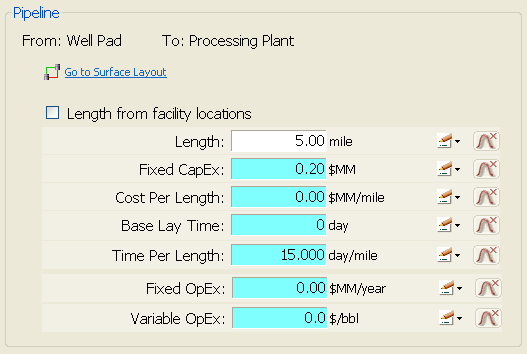Pipeline Laying
The Pipeline Laying job allows you to specify construction details for a pipeline.
This is a special kind of job, since it cannot be created directly but is automatically added by PetroVR when you edit a connection in the Surface Layout and choose to Include pipeline costs and construction times - it is assumed that Pipelines cannot exist without a laying job. Conversely, removing the job will automatically turn the pipeline back into a basic connection, and unchecking that option in the Surface Layout or deleting the connection altogether will automatically delete the job.

The specification area for this job is accessible both when the pipeline is first defined in the Surface Layout and then in the job node itself.
Length from facility locations: Check this box to let PetroVR calculate the length of the pipeline from the location coordinates entered for each connected facility using the feet-per-map-unit equation in the Preferences Tab.
How to Model PipelinesIn the Cost Pane of this job, the CapEx will be calculated on the basis of the Fixed CapEx plus the Cost Per Length (which in turn will be multiplied by the Length); similarly, the Duration will be defined as the Base Lay Time plus the Time Per Length (idem).
- Fixed OpEx: Fixed operating cost for the pipeline, usually measured per year. This is not related to the duration of the laying job, but starts being incurred the moment the pipeline starts processing fluids and continues until it is abandoned.
- Variable OpEx: Variable operating cost per unit of throughput. See Capacity Sub-Tab.
Fixed and Variable OpEx can be used to model tariffs and tolls for pipeline usage.
Activities defined for this job will sum up not to the total job Duration but to the total Base Lay Time. The Duration will still be calculated as Length * Time Per Length + Base Lay Time.
Note also that the default unit for pipeline Length is mile (or km if Metric system is activated in the Preferences Tab) even though the default length unit is foot (or meter). See Units. Similarly, Time Per Length is measured in day/mile.
